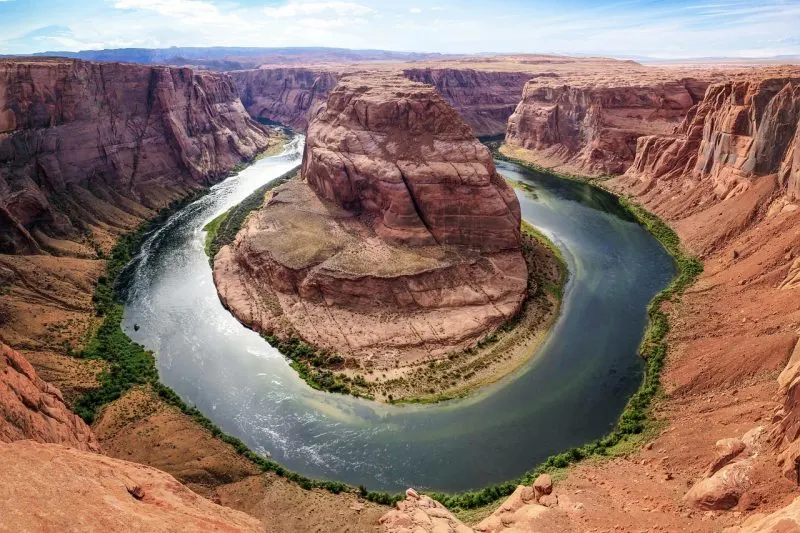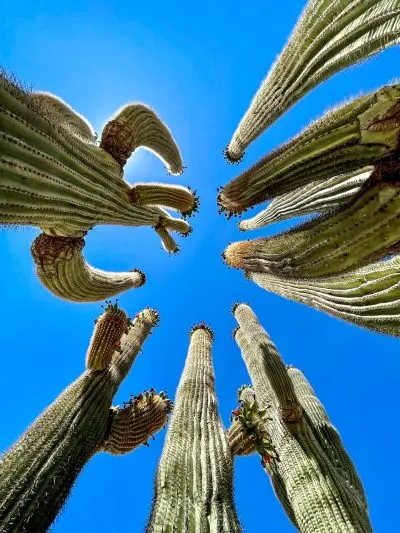Arizona, known as the “Grand Canyon State”, embodies the spirit of the American Southwest, where dramatic desert landscapes meet vibrant life. With its huge canyons, cacti, and national parks like the Grand Canyon, this state attracts those who seek adventure, a warm climate, and a unique connection with nature. Still, living in Arizona comes with its own challenges, from extreme summer heat to long distances between settlements.
This article explores the everyday life, culture, and way of life in this stunning state, discovering what it means to be part of its landscape.
Arizona’s Desert Beauty: Between Canyons, Deserts, and National Parks
Arizona is synonymous with spectacular nature. The Grand Canyon, one of the Seven Wonders of the World, dominates the north of the state, attracting visitors but also reminding residents of the majesty of nature. National parks like the Saguaro, with its iconic cacti, and the Petrified Forest, with its fossilized trees, make Arizona a paradise for nature lovers. Mountains, such as the San Francisco Peaks near Flagstaff, provide a contrast to the desert expanses.
Rivers such as the Colorado and Salt provide rafting, kayaking, and fishing, while desert flora and fauna—coyotes, hawks, and snakes—add dynamism to everyday life. This diversity shapes the mentality of the inhabitants, who learn to respect nature and adapt to its conditions. Whether you live in Phoenix, Tucson, or a smaller place like Sedona, Arizona’s landscapes encourage outdoor activities and a deep connection with the environment.
What a typical day looks like in small towns in Arizona
In Arizona’s smaller towns, life flows at a relaxed but meaningful pace. The day often starts early, especially for those who work in agriculture, tourism, or mining, which have historically shaped the state’s economy. Cotton, citrus, and livestock farming are still important, and many residents spend their days on farms or in orchards. In cities like Prescott or Bisbee, people work in sectors from technology to the arts, as Arizona attracts creatives and entrepreneurs.
In the afternoon, it’s time for family activities or hanging out at local restaurants and shops. The main streets of these towns typically exude Old West charm, with galleries, souvenir shops, and cafés serving burritos and tacos. Weekends are reserved for farmers’ markets, art festivals, or sporting events, like baseball, that bring the community together. The culture is steeped in respect for indigenous heritage and practicality: people are used to relying on themselves and their neighbors, as big cities are sometimes far away.
Traffic in large areas: Challenges and road safety
Arizona is a large state with long distances between cities. Roads like I-10 or US-89 wind through desert expanses, where there are no gas stations, stores, or phone signals. Driving or walking in these conditions requires planning and caution, especially in summer, when temperatures exceed 40°C, or during the monsoon season, when downpours can cause flooding.
Due to the long distances and challenging conditions, traffic accidents, including those involving pedestrians, are not uncommon. If an accident occurs, experienced Arizona pedestrian accident attorneys can help resolve the legal issues, ensuring victims receive the support and compensation they need. Safety depends on preparation: residents carry water, spare tires and extra fuel, and many use radios to communicate in case of trouble. The community often helps drivers and pedestrians in need, showing the strength of solidarity.
Neighborhood spirit and togetherness: What it means to be part of a small community
In Arizona, where towns are often small and neighbors can be miles apart, togetherness is key. People rely on each other, whether it’s organizing a local festival, fixing a fence, or helping out during the summer heat. This spirit is reflected in small gestures—sharing freshly picked fruit, inviting people over for dinner, or working together to clean up after a storm.
Churches, schools, and organizations, such as an Indigenous tribal center, play an important role in bringing people together. For example, festivals like the Tucson Gem Show or the Sedona Art Festival are not just tourist events but opportunities for community-building. This connection makes life in Arizona warmer despite the harsh conditions. Newcomers quickly become part of the community, as residents are known for their hospitality and willingness to help.

Summer in Arizona: Coexistence with nature and extreme conditions
Summer in Arizona is known for extreme heat, with temperatures often exceeding 40°C. Residents prepare in advance, securing coolers, water supplies, and sun protection. Monsoon storms bring relief but also the risk of flooding. Isolation during the hottest days teaches people self-sufficiency and patience.
However, summer also brings joy. Hiking in cooler areas like Flagstaff, swimming in lakes like Lake Havasu, and evening barbecues are popular. Cities like Tucson host outdoor movie nights while kids enjoy water parks. In the summer, nature transforms Arizona into a brilliant desert oasis, where activities adapt to the rhythm of the heat. This experience teaches residents to respect nature and find joy in simple moments.
Local cuisine and way of eating: Tradition, practicality and natural origin
Arizona’s cuisine reflects its multicultural history and desert nature. Burritos, tacos, and chimichangas are inspired by Mexican cuisine, while indigenous dishes like fried bread and posole celebrate the heritage of the Navajo and Hopi tribes.
The diet is practical, but deeply connected to tradition, as families keep recipes for generations. This self-sufficiency reflects the Arizona spirit – living close to the land and culture.
A balance between modern life and the preservation of traditional values
Arizona combines rural charm with modern living. The Internet and telecommuting make it possible to work from cities like Flagstaff or Sedona, attracting tech professionals and artists. Phoenix and Tucson are centers of innovation, but residents still appreciate the simplicity of desert life.
Traditional values, such as respect for family, community, and indigenous heritage, remain intact. Festivals, farmers markets, and rodeos celebrate Arizona’s history while encouraging new residents to embrace this way of life. This balance makes Arizona special: the ability to adapt to the modern world without losing its identity. Life here is not always easy, but it is filled with authenticity, beauty, and deep respect for nature and people.
Living in Arizona is a unique experience that combines dramatic landscapes, community strength and resilience. Whether you dream of adventures in the desert or a quiet life under the stars, Arizona offers room for both. If you’re looking for a place where time is measured by sunsets and friendships, Arizona could be your home.

